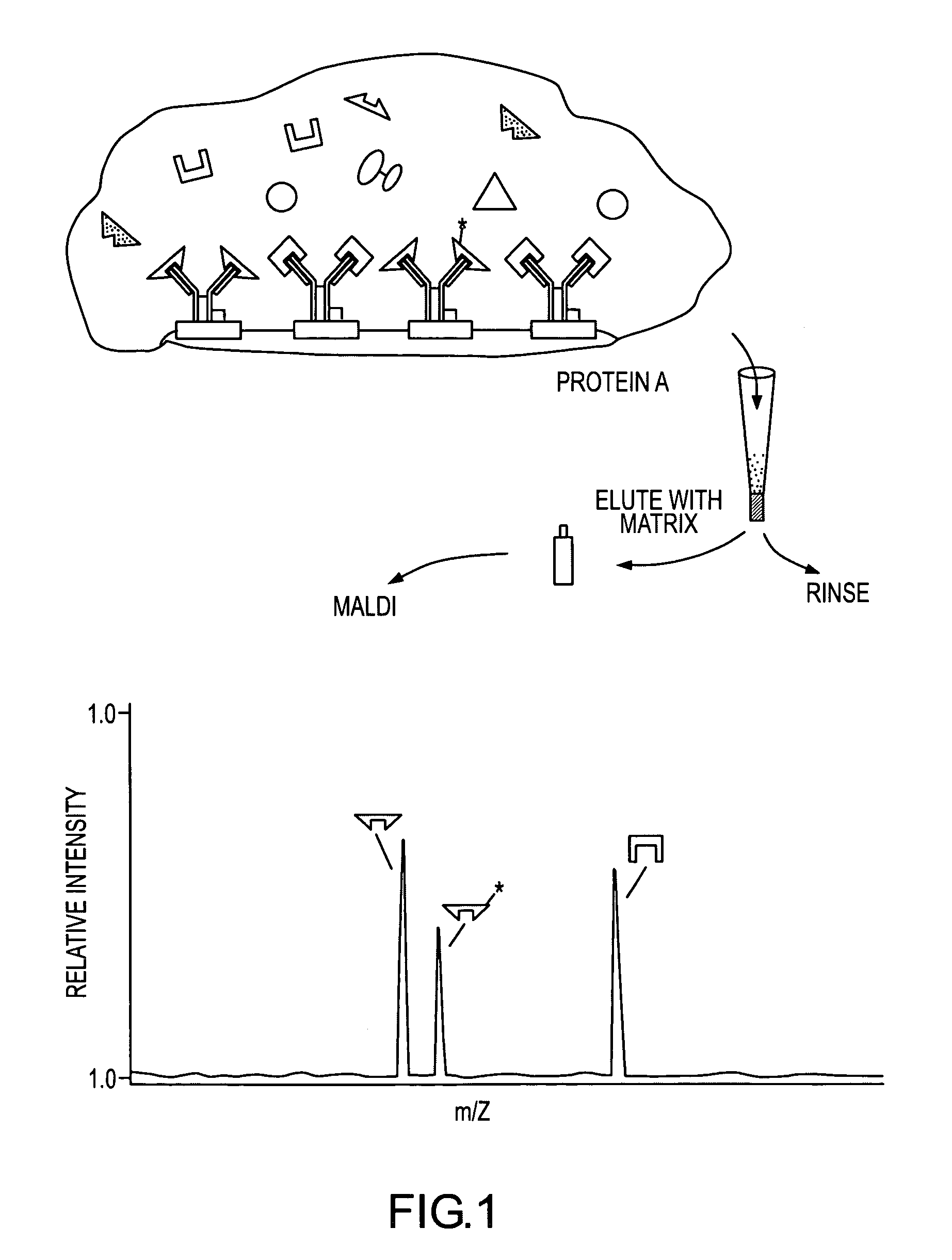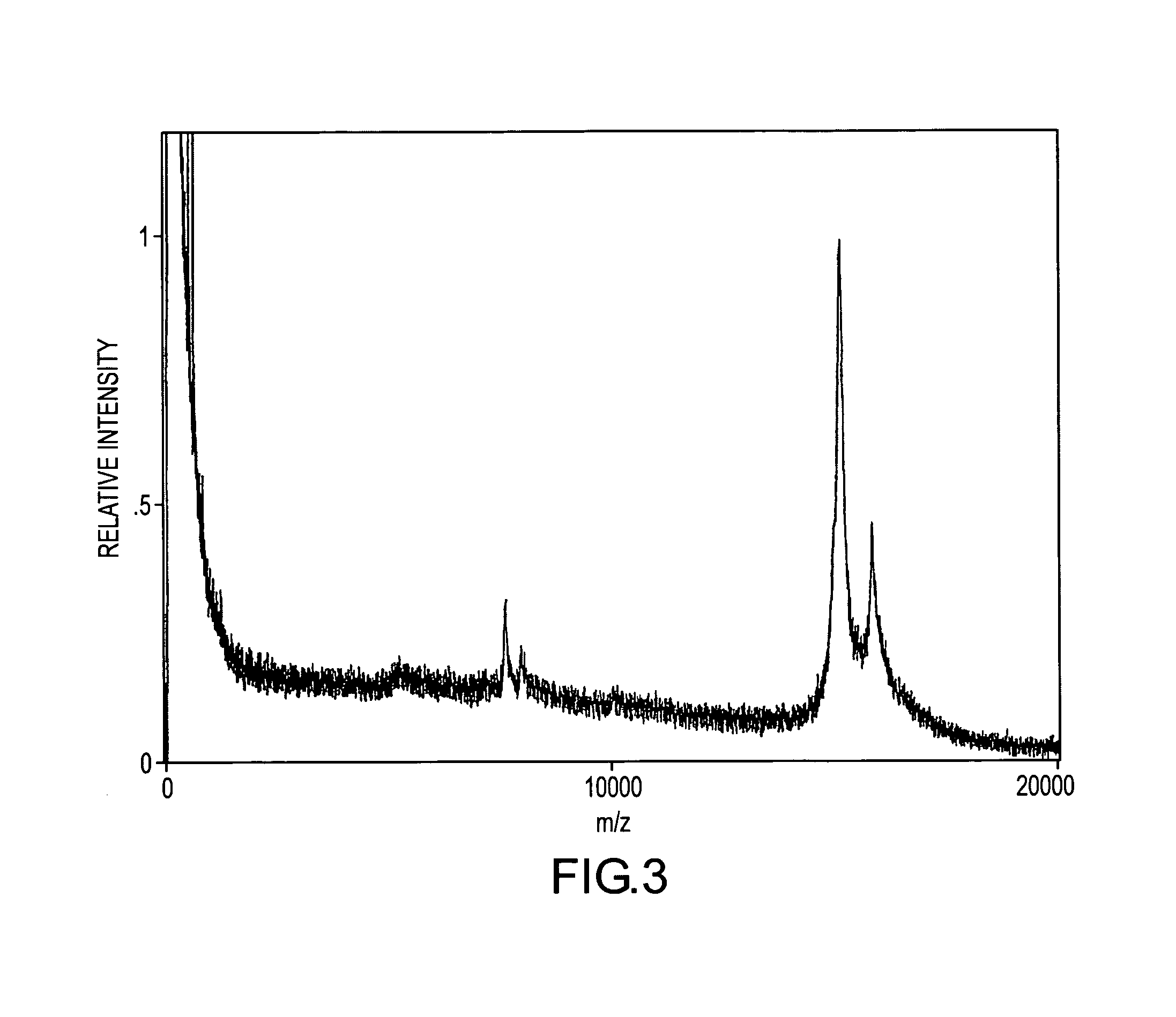Mass spectrometric immunoassay
a mass spectrometry and immunoassay technology, applied in the field of mass spectrometry immunoassays, can solve the problems of limited immunoassay screening possibility, restricted detection limit of technique, and traditional immunoassays that do not operate at that level of detection, and achieve rapid ease and equal reliability.
- Summary
- Abstract
- Description
- Claims
- Application Information
AI Technical Summary
Benefits of technology
Problems solved by technology
Method used
Image
Examples
example 1
[0121]In one practice of the present invention, a single analyte, myotoxin a, was detected in human whole blood using the affinant, anti-myotoxin a, as a constituent of the affinity reagent, and then quantified using a working curve strategy. Myotoxin a is one toxin found in the venom of the prairie rattlesnake, Crotalus viridis viridis (C. v. viridis).
[0122]The antibody, anti-myotoxin a immunoglobulin IgG affinity purified from rabbit antiserum, was used to prepare the affinity reagent as follows. One milliliter of antibody solution (the solution contained the antibody at 5 mg / mL in 0.01 M tris[Hydroxymethyl] aminomethane, pH 8.2 (tris)) was incubated for two hours (gentle agitation at room temperature) with 1 mL of slurried 6% agarose beads on which protein A was supported. Following incubation, the beads were washed (3×1 mL tris) and allowed to react at room temperature with 500 μL of 0.02 M dimethylpimelimidate dihydrochloride prepared in 0.2 M triethanolamine (pH 8.2). The reac...
example 2
[0133]Myotoxin a present in a blood sample containing 0.002 mg / mL of C.v. viridis venom was quantified employing the bargraph quantification strategy. Introduced into the sample were multiple internal reference species of myotoxin a which had been iodinated (at the tyrosine residues) using the following procedure: Iodobeads (Pierce) were washed two times with 0.1 M sodium phosphate at pH 7.0, then incubated for five minutes with 0.4 M sodium iodide in a 0.1 M sodium phosphate solution at pH 7.0. An equal volume of myotoxin a, 2 mg / mL in buffer, was added to the sodium iodide / Iodobead solution. Two Iodobeads were used for each milligram of myotoxin a. The mixture was incubated overnight (˜10 hours) at room temperature, after which the reaction was stopped by removal of the Iodobeads. The modified protein was desalted and stored as described above. The reaction resulted in the production of four distinct iodinated species, with each addition incrementing the molecular weight of myotox...
example 3
[0135]FIG. 6 demonstrates a single-point relative signal strategy for quantifying and detecting myotoxin a in human blood. A human blood sample containing an unknown concentration of myotoxin a and a 30 nM concentration of H-myotoxin a was prepared then mass spectrometrically immunoassayed according to the protocols of Example 1 above. The resulting mass spectrum shows mass spectral signals for myotoxin a, -I-, and H-myotoxin a, -J-, at their respective molecular weights. The relative mass spectrometric responses of myotoxin a and H-myotoxin a may be determined from the mass spectrum of FIG. 2 in which the concentrations of both species are known (25 nM myotoxin a, from the working curve calibration, and 40 nM H-myotoxin a). From this calibration it may be determined that equal concentrations of the two analytes give a 10% lower signal for H-myotoxin a. The myotoxin a signal is 3.5 times the H-myotoxin a signal for a known 30 nM concentration of H-myotoxin a. Therefore the myotoxin ...
PUM
| Property | Measurement | Unit |
|---|---|---|
| molecular weight | aaaaa | aaaaa |
| molecular weight | aaaaa | aaaaa |
| molecular weights | aaaaa | aaaaa |
Abstract
Description
Claims
Application Information
 Login to View More
Login to View More - R&D
- Intellectual Property
- Life Sciences
- Materials
- Tech Scout
- Unparalleled Data Quality
- Higher Quality Content
- 60% Fewer Hallucinations
Browse by: Latest US Patents, China's latest patents, Technical Efficacy Thesaurus, Application Domain, Technology Topic, Popular Technical Reports.
© 2025 PatSnap. All rights reserved.Legal|Privacy policy|Modern Slavery Act Transparency Statement|Sitemap|About US| Contact US: help@patsnap.com



